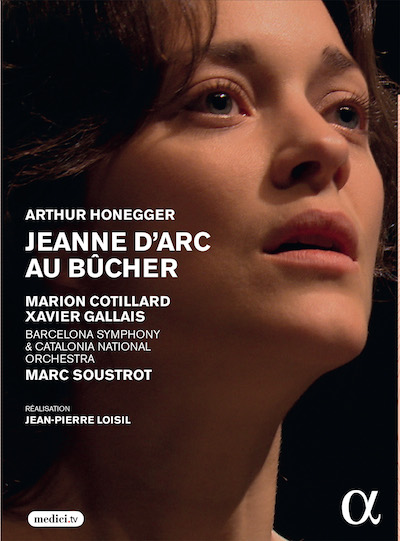
Bringing Joan of Arc to life
The same flute that like a soothsayer announces the coming of darkness symbolizes the soul of Joan of Arc, the “lark” that will rise again at daybreak. Declared innocent of all charges 25 years after her execution and canonized 500 years later, the Maid of Orleans inspired many, including Schiller, Shaw, Brecht, Verdi, Tchaikovsky, Twain and Anouilh’s The Lark. On a personal level, I have to thank composer Arthur Honegger and poet-librettist Paul Claudel for an unforgettable experience, for the key moment that made me a music fan: Jeanne d’Arc au bûcher (Joan of Arc at the Stake) at Buenos Aires’ Teatro Colón almost four decades ago. A shudder ran through the theater that night, through an audience of teenagers, of which I was one. The score was complex, not appropriate for beginners. The piece was a hybrid dramatic oratorio that, thanks to the magic of theater, enthralled the audience by vividly conveying the horror of ignorance and intrigue as conceived by the poet and the composer. It was a horror as present today as it was hundreds of years ago.
More spiritual than political and a symbol and product of an era as dark as the one it portrays, this Jeanne was conceived between 1934 (when Ida Rubinstein, who commissioned and first performed it after attending a medieval mystery representation at the Sorbonne) and 1942, when it premiered in Zurich (though previously in concert at Basel in 1938) as the conclusion of a planned tetralogy of evil, to include works by Milhaud and Stravinsky, that never materialized because World War II intervened. In 1944, Honegger added a prologue, an allegory of the German occupation.
In fewer than 80 minutes we are exposed to 11 scenes of Neoclassical bent featuring excellent effects– neither Bach nor Ravel nor jazz nor the folklore of Lorraine nor the Kurt Weill of Mahagonny are spared. Pianos, saxophones and ondes Martenot, choruses, supporting characters and two protagonists populate a work that in its rawness and causticity inevitably recalls the images of Brueghel and Hieronymus Bosch, from the trial, conducted by pigs, donkeys and other beasts, to the macabre card game that decides the heroine’s fate.
After Ida Rubinstein toured Europe with the oratorio, Vera Zorina starred in its 1948 premiere in the United States. Ingrid Bergman portrayed her at the Paris Opera in 1953, prompting the adaptation that Roberto Rossellini filmed at Naples’ San Carlo Opera House, which rehabilitated her image following the Hollywood pastiche that Victor Fleming had put together in 1948. The role was later played by such figures as Marthe Dugard, Nelly Borgeaud, Felicia Montealegre, Claire Deluca, Sonia Petrovna, Marthe Keller, Isabel Karajan, Dominique Sanda, Sylvie Testud and others. In virtually every version, the tension relies entirely on the narrative thread, the spoken role of Joan, one that in the absence of an exceptional actress loses force and meaning and reveals the work’s flaws.
This concert version features a transfigured Marion Cotillard, a sublime creature, possessor of infinite tenderness and miraculous emotional calibration. Her appearance and voice are moving from the first to the last word, and in her simple reading, devoid of artifice, the French language displays its full glory. There can be no higher praise than to compare her with Renée (Maria) Falconetti, the star of Carl Dreyer’s silent film, The Passion of Joan of Arc, a brilliant actress who, fleeing the Nazi horror (and herself) committed suicide in Buenos Aires in 1946 at the age of 54. Cotillard even looks like her and it is inconsequential whether she studied Falconetti’s performance. The asceticism and visual purity of Honegger’s score recalls that cinematic jewel of 1928. Just as Jean-Luc Godard drew a parallel between Falconetti’s tears and those of actress Anna Karina in his 1962 film Vivre sa vie, the comparison with Cotillard is as logical as it is inevitable. The tears she sheds for humanity at the very end summarize a memorable piece.
She is accompanied by a superb Xavier Gallais as Frère Dominique, the illiterate visionary’s sympathetic confessor and only connection to reality, and Yann Beuron, playing the villains, in addition to Marta Almajano (Marguerite) and Aude Extrémo (Catherine). The Barcelona Symphony, the National Orchestra of Catalonia and the choirs Lieder Camera, Madrigal and Petits Cantors de Catalunya join forces to contribute to the intensity achieved by conductor Marc Soustrot.
This extraordinary DVD of the oratorio, as well as the recent performances, also starring Cotillard and the New York Philharmonic that Côme de Bellescize directed at Avery Fisher Hall, will undoubtedly contribute to spreading the fame of a work that – in its unfortunate relevance – continues to move us now as it did at its premiere and, years later, moved a then-adolescent who to this day cannot but reaffirm his eternal gratitude.

HONEGGER, JEANNE D’ARC AU BûCHER, ALPHA 708 DVD (MEDICI)
Recent Content
-
Artsarticle ·
-
Artsarticle ·
-
Artsarticle ·
